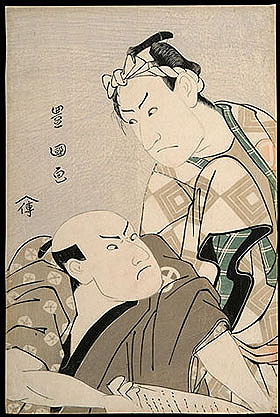|
and villains,
and the contemporary domestic drama (sewamono) with its intrigues
of love, comedy, mystery and vendetta. Schools of actors would
specialize in certain types of roles. Actors belonging to
a particular family would display the family crest (mon) on
their garments, and they usually appear so identified in the
prints. Almost from the very beginning, parts were played
by male actors only, as it was felt by the government that
female actors and dancers would tend to lower the morality
of the people. Consequently certain families or schools of
actors specialized in female roles (onnagata) while others,
such as the Ichikawa school, trained actors mainly for male
roles.
Designing actor prints continued to
occupy Toyokuni throughout the last decade of the 18th century
and into the first years of the 19th century. Influenced no
doubt by Sharaku's great success with the bust portrait, Toyokuni
produced a number of fine designs against light and dark gray
backgrounds for various publishers including Uemura, Tsuruya,
Kinsuke and Yamaguchiya Chusuke. Chusuke was also publishing
Eisho's large bust portraits of courtesans using mica backgrounds
at the same time. Toyokuni's portraits lack the quality of
line and psychological power found in those of Sharaku, but
they contribute a sense of realism to the natural flatness
of the woodcut image, thus giving the figures a disquieting
ambiguity. Toyokuni did a succession of prints from about
1796 showing two companion actors in half and full-length
figures. The scenes were always moments of great emotional
intensity in the play, when the actors were shown to best
advantage in their most characteristic roles. Typical of designs
from this period is a scene of the actors Otani Hiroemon III
with a scroll in hand and Ichikawa Danjuro V in an undisclosed
play. The fact that a play is not mentioned in the design
would seem to indicate that the actors in their roles were
well known to the theater-going public and that the print
appeared concurrently with the production. (see illustration
4)
|
 |
Playwrights, authors, and artists alike
used the teeming life of Edo for inspiration. They frequented
the Yoshiwara, the festivals, and the Kabuki theater for subjects
the people loved: stories about themselves, current fads and
fashions, and events with which they could identify. The writer
Shikitei Samba, author of two volumes entitled 'Actors in
the Third Storey', illustrated by Toyokuni and published by
Nishimiya Shinroku in February 1801, relates in his epilogue,
"From early morning, when the first strains of music
are played by the orchestra, I sit close in front of the stage,
regardless of being splashed by water and mud [from the stage]
and content to bend my knees in a narrow seat and wash down
a few bean-jam buns with tea sipped from a single cup. My
friend Mr. Toyokuni is a man of the same kidney; but he sits
high up in the third storey sketching while I sit low down
in the pit gazing at the actors and doing nothing. We are,
nevertheless, of the same taste; he paints while I write."

illustration 4
(Click
here to continue)
|


